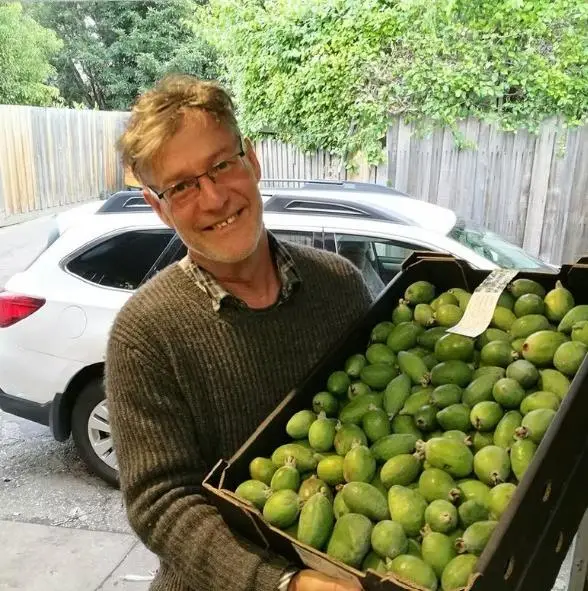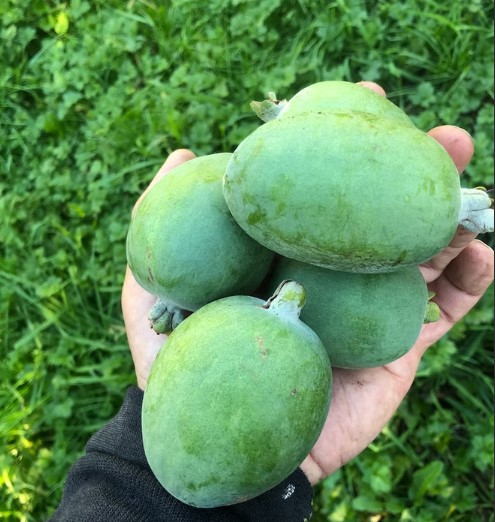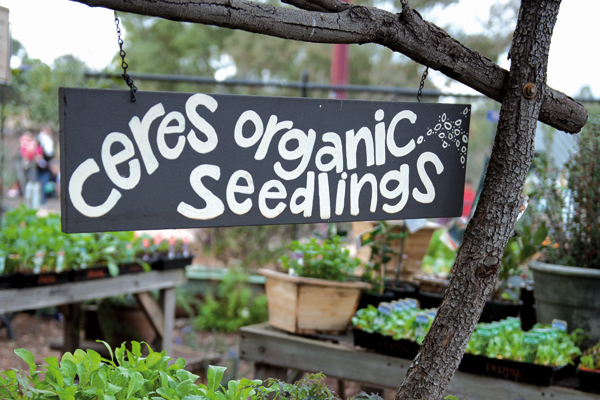
Discovering the people’s fruit
Feijoa grower Paul Haar messaged yesterday from his Archies Creek farm on Gunaikurnai Country – he wanted us to let Fair Food’s feijoa lovers and the Kiwi community in general know that he’d be dropping the first of his feijoas this week.
Feijoas, which are not a guava even though they’re sometimes known as pineapple guavas, grew originally under giant monkey puzzle trees in the highlands of Southern Brazil.
First established outside South America in France, feijoas were brought to Australia and New Zealand in the early 1900’s.
From this point the fate of this nondescript green oval fruit radically diverged.
In Australia, particularly in the South-East, gardeners used feijoas as a hardy medium sized ornamental tree. Assuming the small sweet green feijoa fruits were inedible, they swept them up each year to be chucked in composts or left on the ground to rot.
In New Zealand however, the feijoa became a beloved backyard fixture, with its extremely moreish and shareable fruit eventually helping it obtain a sort of cultural icon status – (no really, they’re right up there with the All Blacks).
I often wonder why feijoas took off in New Zealand but not in Australia – after all they grow well especially in Victoria and Tasmania.
The answer to this riddle lies with one man, Hayward Wright, a kiwi horticultural visionary who had an insatiable passion for breeding fruit trees.
From the 1900’s in his Auckland nursery Wright developed new varieties of oranges, plums, nectarines and of his favourite fruit, persimmons.
Most famously though Hayward Wright was responsible for developing the international kiwifruit industry via his Hayward variety as well as the Goldmine nectarine which went on to become one of the world’s most widely grown.
In the 1920’s and 30’s Hayward Wright developed a larger fruiting feijoa with cultivars he called Mammoth and Triumph.
Understanding the feijoa, which ripens quite rapidly, wasn’t going to be a commercial fruit, Hayward Wright tirelessly travelled the country promoting the feijoa in meetings with local horticultural groups, in newspaper articles and nursery catalogues as the perfect backyard tree.
In one article Wright says of the feijoa “It is bushy and symmetrical in shape, and in spring is a mass of blossom. It has a flavour quite its own, which can only be described as delicious. Its fruit is destined to become one of the very best for jams or jellies.”
Hayward Wright’s feijoa evangelism paid off and the hardy and abundant feijoa became the people’s fruit of New Zealand.
Fast forward three decades to sixties Melbourne and on a bushblock in Warrenwood Alan and Beth Coldicutt, a couple of pioneering environmental engineers with their own passion for fruit trees, had somehow discovered the joys of the feijoa for themselves and soon for their young research assistant, Paul Haar as well.
Paul Haar, who was helping Alan and Beth with their world-first work on thermal performance in buildings, got to know feijoas when he came out to help them take care of their sprawling garden.
Beth would make Paul delicious and refreshing feijoa juices for lunch. Paul expressed an interest in the fruit and so Alan showed him how to grow his own feijoa trees from cuttings.
Paul’s trees grew well but of all the feijoa cuttings the Coldicutt’s gave him there was one that produced much larger fruit than any other – it was a Hayward Wright Mammoth.
In all Paul would go onto grow over 100 feijoa trees on his own farm and as well as Mammoth he would plant Hayward Wright’s Triumph, Superba and Large Round varieties.
Look out for Paul’s feijoa’s appearing later this week for the next four or five weeks in our fruit section.
And if you want to grow your own you can find feijoa trees at the CERES Nursery

Work at CERES
This week there are two great jobs going at CERES.
One at Fair Food for a Digital Content Creator and one as Nursery Manager at the awesome CERES Nursery and Bookstore.
The content creator role is all about telling Fair Food’s stories in words and video and sharing them across our social platforms and in our ads.
Applications close Sunday 27th April.
For plant people CERES Nursery and Bookstore needs no introduction, it’s simply one of the best in Melbourne.
If you have serious people, retail and plant skills then this could be a dream role.
Applications close Monday the 14th of April.
Have a great week
Chris

